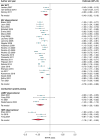Upgrading right ventricular pacemakers to biventricular pacing or conduction system pacing: a systematic review and meta-analysis
- PMID: 36352513
- PMCID: PMC10062368
- DOI: 10.1093/europace/euac188
Upgrading right ventricular pacemakers to biventricular pacing or conduction system pacing: a systematic review and meta-analysis
Abstract
Guidelines recommend patients undergoing a first pacemaker implant who have even mild left ventricular (LV) impairment should receive biventricular or conduction system pacing (CSP). There is no corresponding recommendation for patients who already have a pacemaker. We conducted a meta-analysis of randomized controlled trials (RCTs) and observational studies assessing device upgrades. The primary outcome was the echocardiographic change in LV ejection fraction (LVEF). Six RCTs (randomizing 161 patients) and 47 observational studies (2644 patients) assessing the efficacy of upgrade to biventricular pacing were eligible for analysis. Eight observational studies recruiting 217 patients of CSP upgrade were also eligible. Fourteen additional studies contributed data on complications (25 412 patients). Randomized controlled trials of biventricular pacing upgrade showed LVEF improvement of +8.4% from 35.5% and observational studies: +8.4% from 25.7%. Observational studies of left bundle branch area pacing upgrade showed +11.1% improvement from 39.0% and observational studies of His bundle pacing upgrade showed +12.7% improvement from 36.0%. New York Heart Association class decreased by -0.4, -0.8, -1.0, and -1.2, respectively. Randomized controlled trials of biventricular upgrade found improvement in Minnesota Heart Failure Score (-6.9 points) and peak oxygen uptake (+1.1 mL/kg/min). This was also seen in observational studies of biventricular upgrades (-19.67 points and +2.63 mL/kg/min, respectively). In studies of the biventricular upgrade, complication rates averaged 2% for pneumothorax, 1.4% for tamponade, and 3.7% for infection over 24 months of mean follow-up. Lead-related complications occurred in 3.3% of biventricular upgrades and 1.8% of CSP upgrades. Randomized controlled trials show significant physiological and symptomatic benefits of upgrading pacemakers to biventricular pacing. Observational studies show similar effects between biventricular pacing upgrade and CSP upgrade.
Keywords: Biventricular pacing; Conduction system pacing; Physiological pacing; Upgrade.
© The Author(s) 2022. Published by Oxford University Press on behalf of the European Society of Cardiology.
Conflict of interest statement
Conflict of interest: none declared.
Figures




References
-
- Mond HG, Proclemer A. The 11th world survey of cardiac pacing and implantable cardioverter-defibrillators: calendar year 2009–a World Society of Arrhythmia’s project. Pacing Clin Electrophysiol 2011;34:1013–27. - PubMed
-
- Cicchitti V, Radico F, Bianco F, Gallina S, Tonti S, De Caterina R. Heart failure due to right ventricular apical pacing: the importance of flow patterns. Europace 2016;2:1679–88. - PubMed
-
- Lamas GA, Lee KL, Sweeney MO, Silverman R, Leon A, Yee Ret al. . Ventricular pacing or dual-chamber pacing for sinus-node dysfunction. N Engl J Med 2002;346:1854–62. - PubMed
-
- Wilkoff BL, Cook JR, Epstein AE, Greene HL, Hallstrom AP, Hsia Het al. . Dual-chamber pacing or ventricular backup pacing in patients with an implantable defibrillator: the Dual Chamber and VVI Implantable Defibrillator (DAVID) trial. JAMA 2002;288:3115–23. - PubMed
-
- Curtis AB, Worley SJ, Adamson PB, Chung ES, Niazi I, Sherfesee Let al. . Biventricular pacing for atrioventricular block and systolic dysfunction. N Engl J Med 2013;368:1585–93. - PubMed
Publication types
MeSH terms
Grants and funding
LinkOut - more resources
Full Text Sources
Medical

